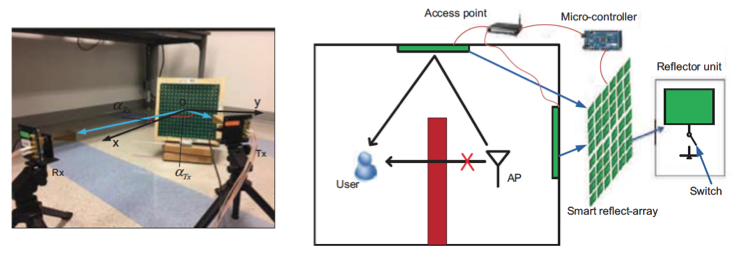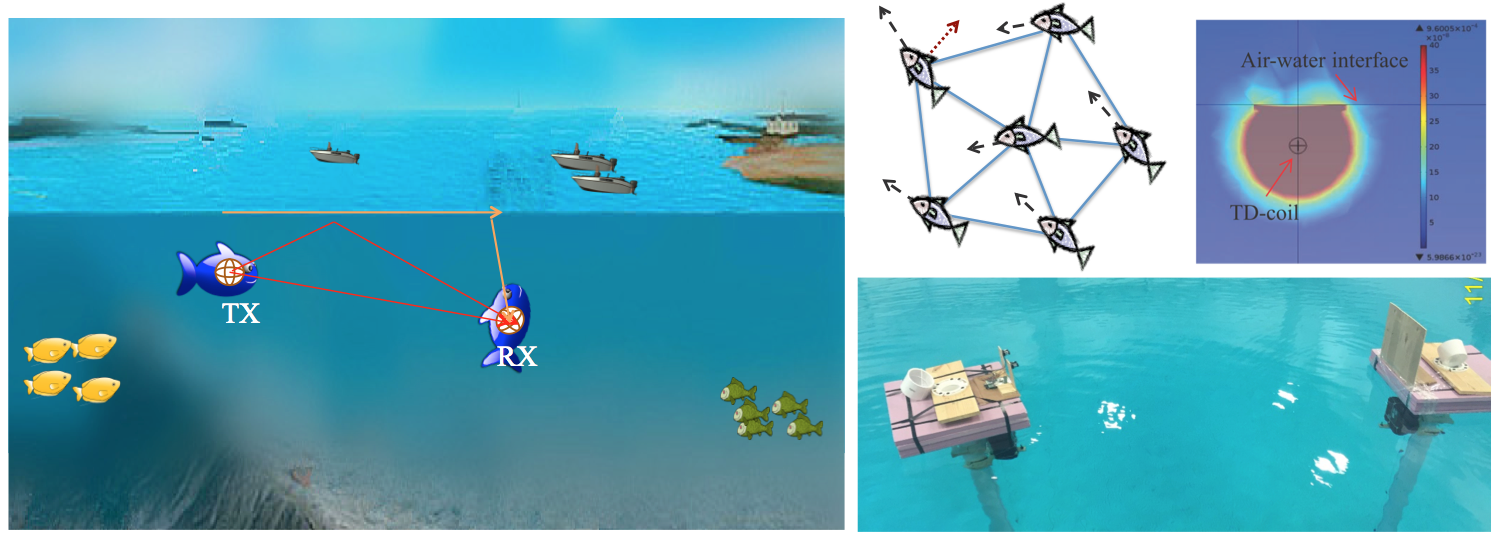I moved to the Department of Electronic Engineering at Tsinghua University in 2021. This website has stopped updating since July 2021. Please find my latest infomation at the new Website.
Research Projects
Metamaterial Inspried Networking in Extreme Environments [Project Website]

Despite the presence of wireless connectivity in most terrestrial scenarios, there are still many extreme environments that cannot be covered,
including underground, underwater, and confined spaces (tunnels, pipelines, and indoor environments with no network infrastructures). Wireless networks in such environments can enable various applications, ranging from
environmental sustainability, homeland security, to military and defense automation. However, existing wireless networking techniques, including electromagnetic wave-based solutions, acoustic wave-based solutions,
and magnetic induction-based solutions, do not work in the aforementioned extreme environments, especially when the target environment has lossy media and complex structure and when the device is small and mobile.
In this project, a new networking paradigm, Metamaterial-inspired Networking (MetaNet), will be developed to wirelessly internetwork portable (or even smaller) devices in extreme environments. MetaNet will generate
significant impacts by providing a new networking platform to establish wireless connection in extreme environments. It can positively impact many human activities and can eventually address many key problems,
such as increasing oil/gas recovery factor, protecting groundwater, mitigating the impacts of natural disasters, establishing smart cities and smart buildings, and enhancing the safety of military and law enforcement personnel.
With the support of the National Science Foundation (2015-2017 and 2017-2022).
Underwater Swarming Cyber-Physical Systems
The project focuses on underwater swarming cyber-physical systems (swarming CPS) consisting of a collection of underwater mobile networked agents, each of which has sensing, computing, communication, and locomotion capabilities,
and that have a wide range of civilian and military applications. The novel Magnetic Induction (MI)-based underwater communication and localization solutions will be developed, which allows robotic fish to timely and reliably exchange messages,
hile simultaneously providing accurate inter-fish localization in the harsh 3D underwater environment. The sensing-motion co-design strategies will be verified and demonstrated using a school of wirelessly interconnected robotic fish in both
lab-based experiments and field experiments. The research solutions of this project aim to bring significant advance in the environmental sustainability, homeland security, and human well-being.
With the support of the National Science Foundation (2014-2018).
Physical-Layer Identification

In wireless communications, the usage of electromagnetic (EM) waves as signal carrier grants both significant challenges and unique opportunities to users' security and privacy.
On the one hand, as the EM waves propagate anywhere within the physics limit through line-of-sight, reflection, diffraction, and refraction paths, it is possible for impostors within the range to participate in the wireless communication.
On the other hand, physical waveforms transmitted by any wireless device are inherently stamped with unique features in the physical layer of the communication, which can be utilized to identify impostors and classify authorized users.
Such device identification solutions are defined as Wireless Physical-Layer Identification (WPLI) techniques. While the conventional software-level device identifications (e.g., IP or MAC address) can be easily changed by malwares,
the physical layer feature cannot be modified without significant effort. This project focuses on the promising WPLI technique for future wireless security solutions.
With the support of the Idaho National Laboratory and the Department of Energy (2017-2020).
Wireless Intra-body Networks for Smart Health Applications

The project is expected to pave the way for the development of in vivo nanosensors networks for biosensing applications with direct application to the next generation of health-centric smartphones and wearable devices.
This technology has the potential to radically change current disease diagnosis and treatment techniques. The idea of improving the accuracy of existing diagnostic techniques based on individual nano-biosensors by utilizing a distributed network
of coordinated nano-devices, is transformative. This project contributes to a much wider and ambitious vision of advanced health-monitoring and drug delivery systems, using a novel interdisciplinary approach to leverage and combine the state-of-the-art
in nano-biosensing, wireless communication and networks, as well as distributed data collection and signal processing. The objective of the proposed research is to prove the feasibility of cooperative spectroscopy for real-time in vivo nano-biosensing applications.
The ultimate goal is to replace the external independent excitation and measurement system used in classical spectroscopy by a network of coordinated nano-devices, able to both excite and measure the response of nano-biofunctional particles.
With the support of the National Science Foundation (2014-2016 and 2017-2020).
60 GHz mmWave Infrastructure: A Cross-Layer Reconfigurable Multi-Gigabit WLAN Testbed

Due to the rapidly growing number of mobile devices and bandwidth hungry applications, industry research predicts a 1000-fold increase in wireless network traffic by 2020. In spite of decades of research on improving spectrum efficiency
in WiFi and cellular networks, existing techniques can only offer short-term solutions. The millimeter-wave (mmWave) technology, e.g., in the unlicensed 60 GHz band supported by the IEEE 802.11ad standard, has recently emerged as an alternative to legacy WiFi,
promising multi-Gigabits per second throughput. Although the commercial use of 60 GHz hardware has been limited until recently to short-range line-of-sight scenarios, e.g., wireless docking, due to the high attenuation and vulnerability to blockage of mmWave signals,
this project envisions the use of mmWave technology for building general purpose, multi-Gigabit wireless Local Area Networks for home and enterprise environments that will offer always-on connectivity but an order of magnitude higher throughput than today's 2.4/5 GHz
WiFi networks. One major factor that has hindered research efforts towards this vision is the lack of testbeds due to the unavailability of 60 GHz hardware that can simultaneously offer both high performance and high levels of reconfigurability and control.
This project will build X60, a software defined based 60 GHz testbed that will offer high level of reconfigurability at the PHY, MAC, and network layer, and, at the same time, support channel widths and speeds commensurate to those of the IEEE 802.11ad standard.
With the support of the National Science Foundation (2016-2018).






